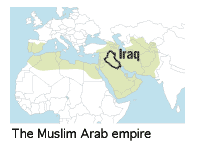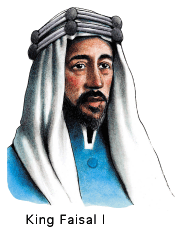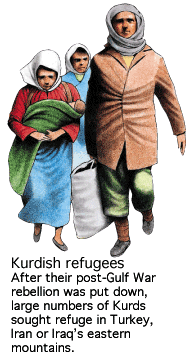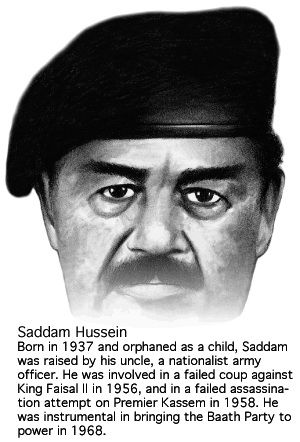| Friday, Apr 04, 2003 | |
| War with Iraq |
| Friday, Apr 04, 2003 | |
| War with Iraq |
|
| |||
| Posted on Sun, Jan. 12, 2003 | |||
|
History: The faded glory
of Iraq
Knight Ridder Tribune Saddam Hussein's nation has been home to some of the most powerful empires in history. Iraq over the centuries saw the birth of civilization, built the first cities and vied to lead the Arab world. War could alter its history once again. EARLY CIVILIZATIONS 550 B.C.-539 B.C. 
Sumer and Babylon Mesopotamia - the ancient region that includes most of present-day Iraq - comes from a Greek word meaning "between two rivers," referring to the plain between the Tigris and Euphrates rivers. Here the world's earliest civilizations developed. The Sumerians settled in southern Mesopotamia about 5500 B.C. They built sophisticated cities, including Ur, Lagash and Babylon, and invented irrigation, written language and the wheel. Around 1890 B.C., Babylon became independent from Sumerian rule and under Hammurabi the Great conquered all of Sumer. This Babylonian king created one of the earliest collections of written law, the Hammurabi code. The first empire of Babylon lasted until 1595 B.C., when it was overrun by Hittite warriors from the region that is now Turkey. 
The Assyrian Empire The Assyrians settled on the shores of the Tigris in northern Mesopotamia by 2000 B.C., and built their capital at Assur. The Assyrians, like the Hittites, were masters of warfare. By 650 B.C., they had created an empire that stretched from Syria to the Persian Gulf. Later Assyrian kings devoted themselves to the arts, and built a vast library in Nineveh. The Second Babylonian Empire The Chaldean people migrated into Mesopotamia around 1100 B.C., and came to dominate the city of Babylon. After destroying Assyria in 609 B.C., the new Babylonians created an empire under Nebuchadnezzar II that encompassed much of the former Assyrian realm. Among his conquests was Jerusalem, where he destroyed the city and forced the Israelites into slavery. Under Nebuchadnezzar's rule, the city of Babylon achieved mythic power and beauty. CENTURIES OF CONQUERORS 539 B.C.-A.D. 637 The fate of Babylon, and all of Mesopotamia, then fell into the hands of foreign powers. First, the Persians in 539 B.C. took control, then the Greeks and Macedonians of Alexander the Great in 331 B.C. By the time the Parthians (a fierce central Asian tribe) gained control of the region in 126 B.C., many of the great cities - including Babylon - had been abandoned. After brief periods of Roman control, the Parthians were replaced in A.D. 227 by the Sassanid Persians, who remained in power until the birth of Islam. 
ISLAM AND THE ARABS 637-1258 Shortly after the death of Muhammad in 632, Arab Muslim armies from what is now Saudi Arabia began vast conquests. In 637, they defeated the Sassanids in Mesopotamia. One hundred years later, the Arabs had forged an Islamic empire that stretched from Spain to China. In 752, the ruling Abbasid dynasty established its new capital near the small village of Baghdad. Under the Abbasids, Arab civilization reached new heights of science, culture and trade. By 800, Baghdad had grown into a wealthy city of more than 1 million people that matched the former glory of nearby Babylon - by then an ancient ruin. But the new Mesopotamians spoke Arabic and worshipped Allah. MONGOLS AND TURKS 1258-1917 The Arab empire gradually lost power, and was finally destroyed in 1258 by Mongol horsemen sweeping in from the east. The Mongols neglected the region, and it deteriorated rapidly. Ottoman Turks incorporated Mesopotamia into their empire in 1534, but the neglect continued. By the 1700s, only about 15,000 people lived in Baghdad. The Ottoman Empire was also in decline, and by the 1800s, Great Britain had become involved in the Persian Gulf region. First, its interest was to protect its trade routes with India. Later, the British found a more important interest - oil. 
BRITISH RULE AND INDEPENDENCE 1917-1958 Middle East oil was first discovered in Persia (now Iran) in 1908. When Turkey entered World War I on the side of Germany, the security of the Anglo-Persian Oil Company was a primary concern for Britain. British forces pushed the Turks out of Mesopotamia and captured Baghdad in 1917. A new nation In 1920, the League of Nations gave Britain a mandate over the region. In 1921, it was renamed Iraq, a new government was established and an Arab prince was installed as King Faisal I. But Britain controlled the new country's army, foreign policy, finances and oil resources. Iraqi opposition to British involvement grew throughout the 1920s, and an independence movement developed. In 1930, Britain agreed to eventual independence in exchange for continued use of military bases in Iraq. The mandate ended in 1932, and Iraq became a sovereign nation. King Faisal worked to unify the various ethnic and religious groups within Iraq's European-drawn boundaries. After King Faisal died in 1933, tribal fighting broke out, and Faisal's successors proved ineffective. Anti-British groups gained influence in the government. The Second World War During World War II, some Iraqi leaders sought an alliance with the Axis powers. When the British attempted to use Iraqi air bases, according to the provisions of the 1930 treaty, fighting erupted. The Iraqi army was defeated, and the pro-Axis leaders fled the country. After the war, Iraq helped to form the Arab League. In 1948, Iraq joined with other members of the league in a war against the newly created state of Israel. The defeat of the Arabs set off popular demonstrations in Iraq. Oil revenues were flowing into the country by this time, and the government built many roads, schools and hospitals. But the sheer quantity of money entering the country caused serious inflation. And many Iraqis were resentful of the government's close ties to the West. Opposition to the monarchy mounted until, in 1958, army officers overthrew the government, killed King Faisal II (grandson of Faisal I), and declared Iraq a republic. THE REPUBLIC 1958-present The army officers of the coup, led by Gen. Abdul Karim Kassem, established a three-man Sovereignty Council, which issued a constitution. Kassem became the republic's premier. The new government reversed Iraq's pro-West policies, moved closer to communist nations and instituted land reform. Ethnic unrest continued, and, in 1961, the Kurds of the north were in open revolt. 
The Baath Party In 1963, members of the nationalist Baath Party assassinated Kassem. The Baathists were in power briefly before another army officer, Abdul Salam Arif, seized control. A bloodless coup, orchestrated largely by Saddam Hussein, succeeded in bringing the Baath Party to power permanently in 1968. A new constitution was written that made the party's absolute control official. The first Baath president, Ahmed Hasan al-Bakr, continued many of Kassem's socialist reforms, building a close relationship with the Soviet Union. In 1973, the Baath government completed a takeover of foreign oil companies working in Iraq. As world oil prices rose dramatically in the 1970s, Iraq's profits were enormous. When Bakr resigned in 1979, Saddam succeeded him. War with Iran The 1979 Iranian revolution was of great concern to the Iraqi government. Fundamentalists in Iran were supporting separatist Kurds in the north, and attempting to incite rebellion among Iraq's minority Shiite population in the south. Iraqi forces invaded Iran in 1980. The ensuing war killed 150,000 Iraqi soldiers, damaged Iraqi oil facilities, and ruined Iraq's economy. A cease-fire was agreed to in 1988. The Kurds, who openly supported Iran during the war, were attacked with poison gas in retaliation. 
The Persian Gulf War Citing disagreements over territory, oil production limits and money owed, Iraq invaded Kuwait in 1990. The United Nations and a coalition of 39 countries, led by the United States, opposed the invasion. In January 1991, after the Iraqi government refused to withdraw, the coalition forces launched airstrikes against Iraq and the occupying forces in Kuwait. Iraqi missiles were fired at Israel and Saudi Arabia. In February, the ground war began. The Iraqi army was defeated after 100 hours of fighting. In March, Kurdish and Shiite uprisings broke out. They were soon crushed by Iraqi forces, and refugees streamed into Turkey and Iran. In April, to protect the Kurds, the coalition set up a "no-fly" zone, banning Iraqi aircraft north of the 36th parallel. A southern no-fly zone to protect the Shiites was established in August 1992. The embargo and weapons inspections As part of the formal cease-fire agreement, Iraq agreed to destroy all of its chemical and biological weapons, dismantle its nuclear weapons program, and submit to U.N. inspectors. In September 1991, the first U.N. inspection team entered Iraq, and found evidence that its nuclear weapons program was more advanced than had previously been believed. Iraqi cooperation with the United Nations didn't last long. In 1993, coalition forces hit Iraq with airstrikes twice - once for refusing to remove missiles from southern Iraq, and once in retaliation for a plot to assassinate former President Bush. In 1994, large numbers of Iraqi soldiers moved toward the Kuwaiti border, but retreated in the face of a U.S. military buildup. In 1997, Iraq barred Americans from U.N. inspection teams, but after Russian mediation they were allowed to return. In 1998, Iraq declared that presidential palaces were off-limits to inspectors. It backed down under threat of force, but inspectors reported that the Iraqis were still not complying. U.N. inspection teams were permanently withdrawn from Iraq in 1998, and the United States and Britain launched four days of sustained airstrikes dubbed Operation Desert Fox. In January 2002, President George W. Bush called Iraq part of an "axis of evil," and began threatening the use of force to bring about a "regime change" in Baghdad. On Nov. 8, the U.N. Security Council unanimously adopted a resolution requiring Iraq to allow weapons inspections or face "serious consequences." Illustrations by Doug Griswold/KRT Sources: "The Kingfisher Book of the Ancient World" by Hazel Mary Martell and Paul Bahn; Dorling Kindersley's "Atlas of World History"; World Book Encyclopedia | |||
| Taken from |